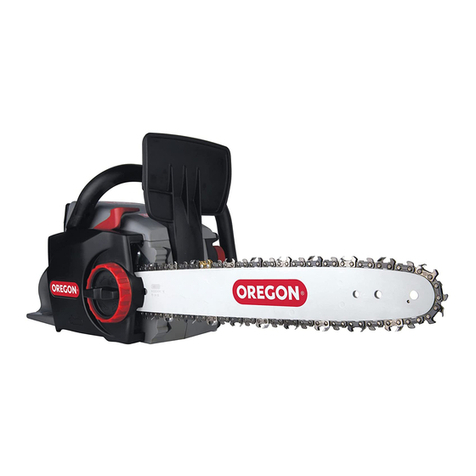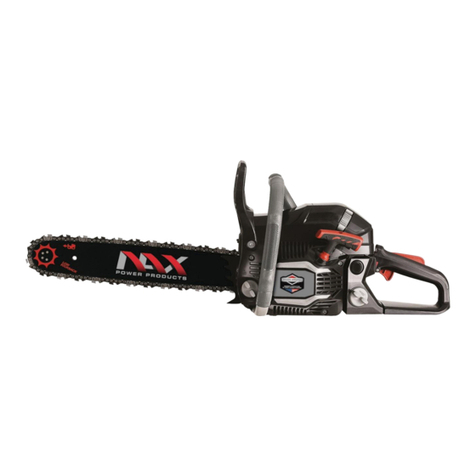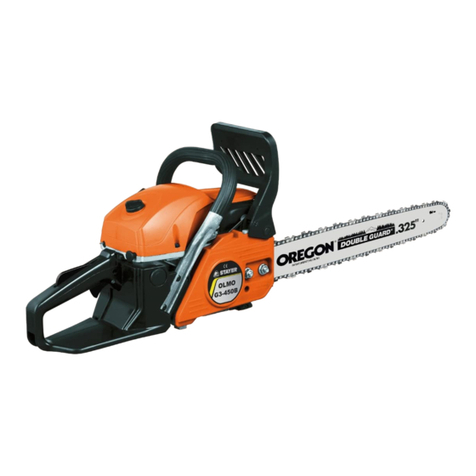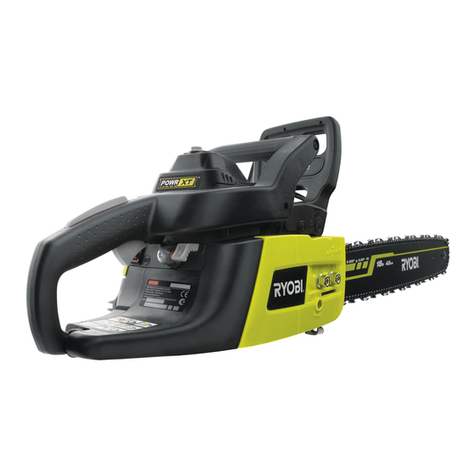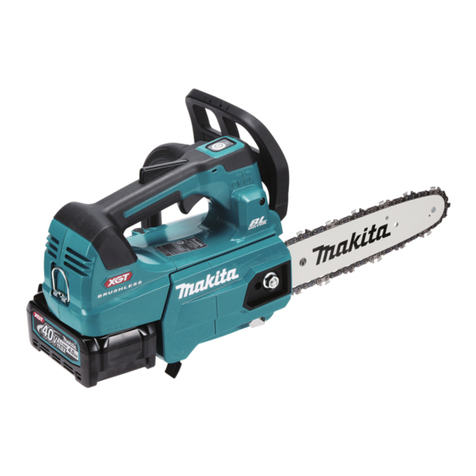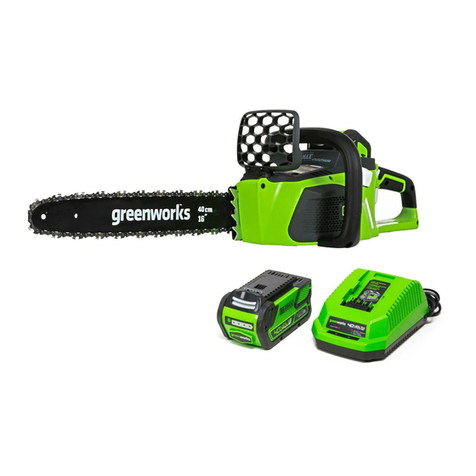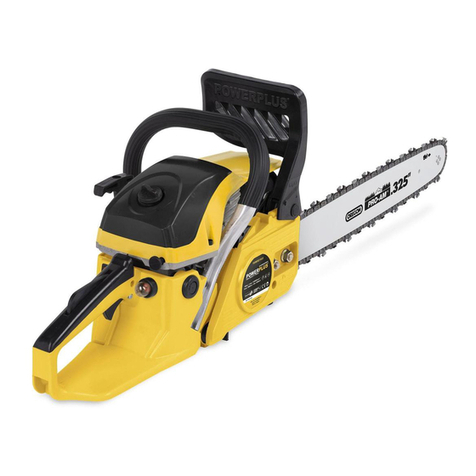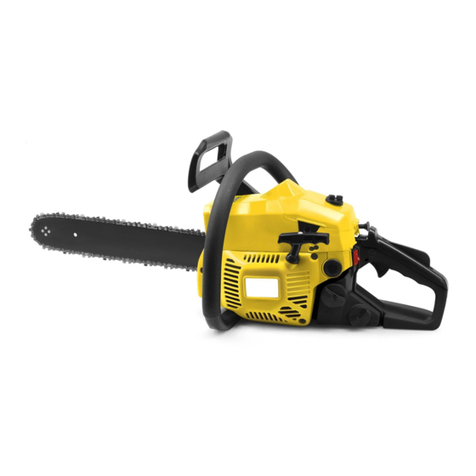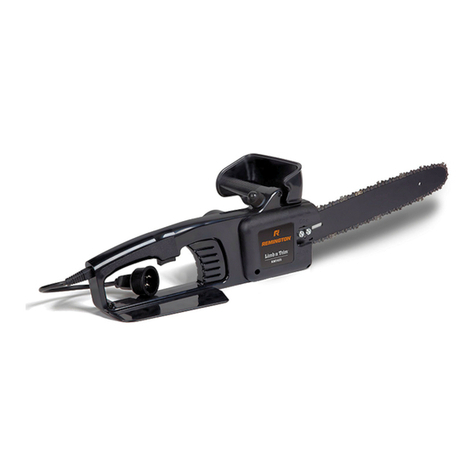XU1 XCSK-0185 User manual

18V LITHIUM
18V LITHIUM
POWERED BY
POWERED BY
18V LITHIUM
POWERED BY
Ozito Industries Pty. Ltd. 25 Fox Drive, Dandenong South, Victoria, Australia 3175
Telephone: 1800 069 486 (Aus), 0508 069 486 (NZ)
XU1 Power tools
XCSK-0185 1121
Operating Instructions
XCSK-0185
18V18V
CordlessCordless
Chainsaw KitChainsaw Kit

SAFETY
INSTRUCTIONS
GENERAL POWER TOOL
SAFETY WARNINGS
2. Electrical safety
a. Power tool plugs must match the
outlet. Never modify the plug in any
way. Do not use any adapter plugs
with earthed (grounded) power tools.
Unmodied plugs and matching outlets will
reduce risk of electric shock.
b. Avoid body contact with earthed or
grounded surfaces, such as pipes,
radiators, ranges and refrigerators.
There is an increased risk of electric shock if your
body is earthed or grounded.
c. Do not expose power tools to rain or
wet conditions. Water entering a power tool
will increase the risk of electric shock.
d. Do not abuse the cord. Never use
the cord for carrying, pulling or
unplugging the power tool. Keep
cord away from heat, oil, sharp edges
or moving parts. Damaged or entangled
cords increase the risk of electric shock.
e. When operating a power tool
outdoors, use an extension cord
suitable for outdoor use. Use of a cord
suitable for outdoor use reduces the risk of
electric shock.
f. If operating a power tool in a
damp location is unavoidable, use
a residual current device (RCD)
protected supply. Use of an RCD reduces
the risk of electric shock.
3. Personal safety
a. Stay alert, watch what you are
doing and use common sense when
operating a power tool. Do not use
a power tool while you are tired or
under the inuence of drugs, alcohol
or medication. A moment of inattention
while operating power tools may result in serious
personal injury.
b.Use personal protective equipment.
Always wear eye protection. Protective
equipment such as dust mask, gloves, non-skid
safety shoes, hard hat, or hearing protection used
for appropriate conditions will reduce personal
injuries.
c. Prevent unintentional starting.
Ensure the switch is in the o-
position before connecting to power
source and/or battery pack, picking
up or carrying the tool. Carrying power
tools with your nger on the switch or energising
power tools that have the switch on invites
accidents.
d. Remove any adjusting key or wrench
before turning the power tool on. A
wrench or a key left attached to a rotating part of
the power tool may result in personal injury.
e. Do not overreach. Keep proper
footing and balance at all times.
This enables better control of the power tool in
unexpected situations.
f. Dress properly. Do not wear loose
clothing or jewellery. Keep your
hair, clothing and gloves away from
moving parts. Loose clothes, jewellery or
long hair can be caught in moving parts.
g. If devices are provided for the
connection of dust extraction and
collection facilities, ensure these are
connected and properly used. Use of
dust collection can reduce dust-related hazards.
h. Do not let familiarity gained from
frequent use of tools allow you to
become complacent and ignore tool
safety principles. A careless action can
cause severe injury within a fraction of a second.
ELECTRICAL SAFETY
WARNING! Read all safety warnings
and all instructions. Failure to follow the
warnings and instructions may result in
electric shock, re and/or serious injury.
Save all warnings and
instructions for future reference.
The term “power tool” in all of the warnings
refers to your mains-operated (corded)
power tool or battery-operated (cordless)
power tool.
WARNING! Read all safety warnings and
all instructions. Failure to follow the warnings
and instructions may result in electric shock,
re and/or serious injury.
Save all warnings and instructions for future
reference. The term “power tool” in the warnings
refers to your mains-operated (corded) power tool or
battery-operated (cordless) power tool.
1. Work area safety
a. Keep work area clean and well lit.
Cluttered or dark areas invite accidents.
b. Do not operate power tools in
explosive atmospheres, such as in
the presence of ammable liquids,
gases or dust. Power tools create sparks
which may ignite the dust or fumes.
c. Keep children and bystanders
away while operating a power tool.
Distractions can cause you to lose control.
Description of symbols
Read the whole manual carefully and make sure you
know how to switch the tool off in an emergency,
before operating the tool.
Save these instructions and other documents
supplied with this tool for future reference.
This tool has been designed for 230V and
240V only. Always check that the power supply
corresponds to the voltage on the rating plate.
Note: The supply of 230V and 240V on Ozito tools
are interchangeable for Australia and New Zealand.
This tools charger is double insulated in accordance
with AS/NZS 60745-1; therefore no earth wire is
required.
Using an Extension Lead
Always use an approved extension lead suitable
for the power input of this tool. Before use, inspect
the extension lead for signs of damage, wear and
ageing. Replace the extension lead if damaged or
defective.
When using an extension lead on a reel, always
unwind the lead completely. Use of an extension
lead not suitable for the power input of the tool or
which is damaged or defective may result in a risk of
re and electric shock.
The power supply for this product should be
protected by a residual current device (rated at
30mA or less). A residual current device reduces the
risk of electric shock.
Read instruction manual
Warning
V Volts
Hz Hetz
~ Alternating current
WWatts
dc/ Direct current
Ø Diameter
mA Milliamperes
no No load speed
/min Revolutions or reciprocation per minute
Double insulated
Regulator compliance mark
Do not incinerate
Thermal cut-out protection
Indoor use only
Lithium Ion-battery
Sound power level
Recycle battery
Do not put in rubbish
Do not use in the rain or leave the tool
outdoors while raining
Do not get battery wet
Do not use or store battery in temperatures
exceeding 50°C
Wear safety gloves
97
Wear ear muffs & safety glasses
Always hold the chainsaw with both
hands
Keep bystanders away. Do not saw whilst
people especially children or pets are in
the area
Beware of kickback
Blade continues to rotate after the machine
is switched off. Wait until all machine
components have completely stopped
before touching them.
1
WARNING! When using mains-powered
tools, basic safety precautions, including
the following, should always be followed to
reduce risk of re, electric shock, personal
injury and material damage.

2
4. Power tool use and care
a. Do not force the power tool. Use
the correct power tool for your
application. The correct power tool will do the
job better and safer at the rate for which it was
designed.
b. Do not use the power tool if the
switch does not turn it on and o. Any
power tool that cannot be controlled with the
switch is dangerous and must be repaired.
c. Disconnect the plug from the power
source and/or the battery pack from
the power tool before making any
adjustments, changing accessories,
or storing power tools. Such preventive
safety measures reduce the risk of starting the
power tool accidentally.
d. Store idle power tools out of the
reach of children and do not allow
persons unfamiliar with the power
tool or these instructions to operate
the power tool. Power tools are dangerous
in the hands of untrained users.
e. Maintain power tools. Check for
misalignment or binding of moving parts,
breakage of parts and any other condition
that may affect the power tool’s operation. If
damaged, have the power tool repaired before
use. Many accidents are caused by poorly
maintained power tools.
f. Keep cutting tools sharp and clean.
Properly maintained cutting tools with sharp
cutting edges are less likely to bind and are easier
to control.
g. Use the power tool, accessories
and tool bits etc. in accordance
with these instructions, taking into
account the working conditions and
the work to be performed. Use of the
power tool for operations different from those
intended could result in a hazardous situation.
h. Keep handles and grasping surfaces
dry, clean and free from oil and
grease. Slippery handles and grasping
surfaces do not allow for safe handling and
control of the tool in unexpected situations.
5) Battery tool use and care
a) Recharge only with the charger
specied by the manufacturer. A
charger that is suitable for one type of battery
pack may create a risk of re when used with
another battery pack.
b) Use power tools only with
specically designated battery
packs. Use of any other battery packs may
create a risk of injury and re.
c) When battery pack is not in use, keep
it away from other metal objects,
like paper clips, coins, keys, nails,
screws or other small metal objects,
that can make a connection from one
terminal to another. Shorting the battery
terminals together may cause burns or a re.
d) Under abusive conditions, liquid may
be ejected from the battery; avoid
contact. If contact accidentally occurs, ush
with water. If liquid contacts eyes, additionally
seek medical help. Liquid ejected from the
battery may cause irritation or burns.
e) Do not use a battery pack or tool that
is damaged or modied. Damaged or
modied batteries may exhibit unpredictable
behaviour resulting in re, explosion or risk of
injury.
BATTERY & CHARGER
SAFETY WARNINGS
BEFORE USING THE CHARGER OR
BATTERY READ ALL INSTRUCTIONS
AND CAUTIONARY MARKINGS ON THE
CHARGER, BATTERY PACK AND THE
PRODUCT USING THE BATTERY PACK. DO
NOT LOSE THESE SAFETY INSTRUCTIONS.
Battery warnings
1. The battery pack is not fully charged out of the carton. First
read the safety instructions and then follow the charging
notes and procedures.
2. For optimum battery performance avoid low discharge
cycles. Charge the battery pack frequently.
3. Use and store the battery pack in dry conditions with low
humidity between 0-50°C, ideally at 15°C. Avoid exposing
battery pack and charger to direct sunlight.
4. Do not keep battery pack in places where temperatures are
liable to reach over 50°C, such as in a car, metal shed or
similar that is in direct sunlight.
5. Do not ignite the battery pack or expose it to re. There is a
risk of explosion!
6. Do not exhaustively discharge batteries. Exhaustive
discharge will damage the battery cells. The most common
cause of exhaustive discharge is long-term storage and
continued use of low-charge batteries. Always store the
battery with some charge. Charge the batteries every 2-3
months to restore charge. Stop working as soon as the
performance of the battery falls noticeably or the electronic
protection system triggers.
7. Protect batteries and the tool from overloads. Overloads
will quickly result in overheating and cell damage inside the
battery housing without this overheating being apparent
externally.
8. Avoid damage and shocks. Do not use batteries which
have been dropped from a height of more than one meter
or strong external impact, even if the housing of the battery
pack appears to be undamaged. The battery cells inside
the battery may have suffered serious damage.
9. If the battery pack suffers overloading and overheating,
the integrated protective cut-off will switch off the
equipment. Do not press the ON/OFF switch on the tool if
the protective cut-off has actuated. This may damage the
battery pack. Allow the battery to cool to room temperature
before use.
10. Use only original battery packs. The use of other batteries
may result in injuries, explosion and a re risk.
11. Protect your rechargeable battery against moisture, rain
and high humidity. Moisture, rain and high humidity can
cause dangerous cell damage. Never charge or use
batteries which have been exposed to moisture, rain or
high humidity.
12. Never attempt to open the battery pack for any reason. If
the plastic housing of the battery pack is damaged, do not
use the battery.
13. When battery pack is not in use, keep it away from other
metal objects, like paper clips, coins, keys, nails, screws
or other small metal objects, that can make a connection
from one terminal to another. Shorting the battery
terminals together may cause burns or a re.
14. Under abusive conditions, liquid may be ejected from the
battery; avoid contact. If accidental contact occurs, ush
with water and seek medical help immediately. Liquid
ejected from the battery may cause irritation or burns.
15. Do not use a battery pack or tool that is damaged or
modied. Damaged or modied batteries may exhibit
unpredictable behaviour resulting in re, explosion or risk
of injury.
16. Do not expose a battery pack or tool to re or excessive
temperature. Exposure to re or temperature above 130
°C may cause explosion.
17. Never service damaged battery packs. Service of battery
packs should only be performed by the manufacturer.
18. Do not disassemble Battery. This may result in a risk of
electric shock, electrocution or re.
Charger and the charging process warnings
1. Please check the data marked on the rating plate of the
battery charger. Ensure to only connect the battery charger
to a power supply with the voltage marked on the rating
plate.
2. Protect the battery charger and its cable from damage
and sharp edges. Have damaged cables repaired by an
authorised service agent before use.
3. Keep the battery charger, batteries and the cordless tool
out of children’s reach.
4. Do not use damaged battery chargers.
5. Do not use the supplied battery charger to charge other
cordless tools. Only charge XU1 rechargeable batteries
with an XU1 Charger.
6. The battery pack may become warm during use. Allow
the battery pack to cool to room temperature before
commencing with the charging.
7. Do not over-charge batteries. Do not exceed the maximum
charging times. These charging times only apply to
discharged batteries. Frequent insertion of a charged or
partly charged battery pack will result in over-charging and
cell damage. Do not leave fully charged batteries in the
charger.
8. Charge the battery pack in dry conditions with low humidity
between 0-25°C. Avoid exposing battery pack and charger
to direct sunlight. Charge indoors only.
9. Do not use batteries which have suffered deformation
during the charging process or shows any other signs
of abnormalities including, excessive curvature of the
housing, gassing, hissing or cracking.
10. Never fully discharge the battery pack. A complete
discharge of the battery pack will lead to premature
ageing of the battery cells.
11. Never charge the batteries unsupervised.
12. Do not cover or place any object on top of the charger,
place the charger away from heat sources.
13. To reduce risk of damage to the electric plug and cord,
pull by the plug rather than the cord when disconnecting
the charger.
14. Make sure the cord is located so that it will not be stepped
on, tripped over, or otherwise subjected to damage or
stress.
15. An extension cord should not be used unless necessary.
Use of an improper extension cord could result in the risk
of re, electric shock or electrocution.
f) Do not expose a battery pack or tool
to re or excessive temperature.
Exposure to re or temperature above 130 °C
may cause explosion.
g) Follow all charging instructions and
do not charge the battery pack or
tool outside the temperature range
specied in the instructions. Charging
improperly or at temperatures outside the
specied range may damage the battery and
increase the risk of re.
6) Service
a) Have your power tool serviced by a
qualied repair person using only
identical replacement parts. This
will ensure that the safety of the power tool is
maintained.
b) Never service damaged battery
packs. Service of battery packs should only
be performed by the manufacturer or authorized
service provider.

2
9.53mm(3/8) 1.1mm(.043”) 40 Links
CARING FOR THE
ENVIRONMENT
Power tools that are no longer usable
should not be disposed of with household
waste but in an environmentally friendly
way.
Please recycle where facilities exist.
Check with your local council authority for
recycling advice.
Check with your local council authority for recycling
advice.
Recycling packaging reduces the need
for landll and raw materials. Reuse of
recycled material decreases pollution in
the environment. Please recycle packaging
where facilities exist.
3
16. Do not disassemble charger. This may result in a risk of
electric shock, electrocution or re.
17. To reduce risk of electric shock, unplug the charger from
the outlet before attempting any cleaning. Removing the
battery pack will not reduce this risk.
18. Do not use the cordless tool or the battery charger near
vapours and inammable liquids.
• Keep all parts of the body away from the
saw chain when the chain saw is operating.
Before you start the chain saw, make sure
the saw chain is not contacting anything.
A moment of inattention while operating chain saws may
cause entanglement of your clothing or body with the saw
chain.
• Always hold the chain saw with your right
hand on the rear handle and you left hand
on the front handle. Hold the chain saw with
a reversed hand conguration increases the risk of
personal injury and should never be done.
• Hold the power tool by insulated gripping
surfaces only, because the chain may
contact hidden wiring. Saw chains contacting a
“live” wire may make exposed metal parts of the power
tool “live” and could give the operator an electric shock.
• Wear safety glasses and hearing protection.
Further protective equipment for head,
hands, legs and feet is recommended.
Adequate protective clothing will reduce personal injury
by ying debris or accidental contact with the saw chain.
• Do not operate a chain saw in a tree, on
a ladder, from a rooftop, or any unstable
support. Operation of a chain saw in this manner could
result in serious personal injury.
• Always keep proper footing and operate
the chainsaw only when standing on xed,
secure and level surface. Slippery or unstable
surfaces such as ladders may cause a loss of balance or
control of the chain saw.
• When cutting a limb that is under tension
be alert for spring back. When the tension in the
wood bres is released the spring loaded limb may strike
the operator and/or throw the chain saw out of control.
• Use extreme caution when cutting brush
and saplings. The slender material may catch the
saw chain and be whipped towards you or pill you off
balance.
• Carry the chain saw by the front handle with
the chain saw switched o and away from
your body. When transporting or storing the
chain saw always t the guide bar cover.
Proper handling of the chain saw will reduce the likelihood
of accidental contact with the moving saw chain.
• Follow instructions for lubricating, chain
tensioning and changing accessories.
Improperly tensioned or lubricated chain may either break
or increase the chance for kickback
• Keep handles dry, clean, and free from oil
and grease. Greasy, oily handles are slippery causing
loss of control.
• Cut wood only. Do not use chain saw for
purposes not intended. For example: do not
use chain saw for cutting plastic, masonry or non-wood
building materials. Use of the chain saw for operations
different than intended could result in a hazardous
situation.
• Do not attempt to fell a tree until you have
an understanding of the risks and how to
avoid them. Serious injury could occur to the operator
or bystanders while felling a tree.
Causes and operator prevention of kickback
Kickback may occur when the nose or tip of the guide bar
touches an object, or when the wood closes in and pinches
the saw chain in the cut.
CHAINSAW SAFETY
WARNINGS
Tip contact in some cases may cause a sudden reverse
reaction, kicking the guide bar up and back towards the
operator.
Pinching the saw chain along the top of the guide bar may
push the guide bar rapidly back towards the operator.
Either of these reactions may cause you to lose control of the
saw which could result in serious personal injury. Do not rely
exclusively upon the safety devices built into your saw. As a
chain saw user, you should take several steps to keep your
cutting jobs free from accident or injury.
Kickback is the result of tool misuse and/or incorrect
operating procedures or conditions and can be avoided by
taking proper precautions as given below:
• Maintain a rm grip, with thumbs and
ngers encircling the chain saw handles,
with both hands on the saw and position
your body and arm to allow you to resist
kickback forces. Kickback forces can be controlled
by the operator, if proper precautions are taken. Do not let
go of the chain saw.
• Do not overreach and do not cut above
shoulder height. This helps prevent unintended tip
contact and enables better control of the chain saw in
unexpected situations.
• Only use replacement bars and chains
specied by the manufacturer. Incorrect
replacement bars and chains may cause chain breakage
and/or kickback.
• Follow the manufacturer’s sharpening and
maintenance instructions for the saw chain.
Decreasing the depth gauge height can lead to increased
kickback.
WARNING! When servicing, use only
identical replacement parts. Use of any other
parts may create a hazard or cause product
damage. To ensure safety and reliability, all
repairs should be performed by a qualied
service technician.
WARNING! This appliance is not intended
for use by persons (including children)
with reduced physical, sensory or mental
capabilities, or lack of experience and
knowledge, unless they have been given
supervision or instruction concerning use of
the appliance by a person responsible for
their safety. Children should be supervised
to ensure that they do not play with the
appliance.
Cleaning
• Keep the handles free of grease so that you can
maintain a rm grip.
• Clean the device as required with a damp cloth and,
if necessary, mild washing up liquid.
• If the chainsaw is not to be used for an extended
period of time then you should remove the chain
oil from the tank. Briey immerse the chain and the
cutter rail in an oil bath and then wrap them in oil
paper.
• Ensure that the guide bar cover is in place when
storing.
Note: XU1 will not be responsible for any damage
or injuries caused by the repair of the tool by an
unauthorised person or by mishandling of the tool.
WARNING! Before cleaning your
chainsaw or carrying out any maintenance
procedure, make sure that the motor is
off and the battery removed to prevent
accidental starting.
WARNING! Never immerse any part of
the tool in liquid.
WARNING! Store the chainsaw in a
safe and dry place out of the reach of
children
SPARE PARTS
Chain Replacement
The chain can be purchased through Ozito spare parts
or from your local Bunnings Warehouse. The correct
chain can be purchased by matching the pitch, gauge
and number of links as shown below:
Spare parts can be ordered from the Special Orders
Desk at your local Bunnings Warehouse.
For further information, or any parts not listed here,
visit www.ozito.com.au or contact Ozito Customer
Service:
Australia 1800 069 486
New Zealand 0508 069 486
E-mail: [email protected]

18V LITHIUM
18V LITHIUM
POWERED BY
POWERED BY
18V LITHIUM
POWERED BY
18V LITHIUM
Suits:OCS-018
ION
18V LITHIUM
Suits:XCSK-0185
3mm gap is
the ideal tension
3mm gap is
the ideal tension
3mm gap is
the ideal tension
3mm gap is
the ideal tension
3mm gap is
the ideal tension
3mm gap is
the ideal tension
3mm gap is
the ideal tension
A B
E F
C
D
1. Battery seating
2. Rear handle
3. On/off trigger
4. Oil level window
5. Side cover
6. Side cover lock
7. Chain
8. Guide bar
9. Bucking spikes
10. Safety chain brake
11. Front handle
12. Chain oil tank cap
13. Motor cover
14. Lock-off button
15. Guide bar cover
16. Battery
17. Battery release tab
18. Charger adaptor
19. Charging cradle
20. Wrench
4
3 4 5 6 7
109
1 2 8
11 12 13 14
15 16 17 18 19
20

3mm gap is
the ideal tension
3mm gap is
the ideal tension
18V LITHIUM
POWERED BY
18V LITHIUM
POWERED BY
18V LITHIUM
POWERED BY
18V LITHIUM
ION
POWEREDBY
18V LITHIUM
POWEREDBY
18V LITHIUM
POWEREDBY
18V LITHIUM
POWERED BY
18V LITHIUM
ION
POWERED BY
18V LITHIUM
POWERED BY
18V LITHIUM
POWERED BY
18V LITHIUM
POWERED BY
18V LITHIUM
POWERED BY
18V LITHIUM
POWEREDBY
18V LITHIUM
POWEREDBY
18V LITHIUM
POWERED BY
18V LITHIUM
POWERED BY
18V LITHIUM
POWERED BY
18V LITHIUM
POWERED BY
RUN
BRAKE ON BRAKE OFF
STOP
18V LITHIUM
POWERED BY
18V LITHIUM
POWERED BY
RUN
BRAKE ON
BRAKE OFF
STOP
STRAIGHT
ARM
POSITION
CHAIN
LINE
LEFT HAND
CUTTERS
RIGHT HAND
CUTTERS
30°
30°
Voltage: 18V
Chain Speed: 4.3m/s
Bar Length: 254mm (10”)
Chain Pitch: 9.53mm (3/8”)
Oil Tank Capacity: 220ml
Battery: 1.5Ah Li-Ion
Charge Time: 3 Hours
Charger Input: 100-240V AC, 50-60Hz, 17W
Charger Output: 18V DC, 500mA
Tool Weight: 3.3kg
SPECIFICATIONS
5
PROPER USE
This tool is intended for use in a DIY (Do It Yourself)
context or for hobbyist purposes. It is not built for
continuous daily use in a trade or professional
capacity.
Before using the machine, carefully read these
instructions, especially the safety rules to help ensure
that your machine always operates properly.
Before attempting to operate the machine, familiarise
yourself with the controls and make sure you know
how to stop the machine quickly in an emergency.
Save these instructions and the other documents
supplied with this machine for future reference.
ASSEMBLY
WARNING! Ensure the tool is turned off
and battery disconnected before performing
any of the following operations. Wear gloves,
blades are sharp.
WARNING! Do not use any attachments
or accessories not recommended by the
manufacturer of this product, as it can result in
serious personal injury.
Fitting the Chain & Bar
1. Completely unscrew the side cover lock, in a
counter clockwise direction and remove the guide
bar cover FIG. A
2. Fit the chain over the guide bar, making sure the
cutters are facing the direction of rotation. FIG. B
3. Place the guide bar and chain in position, ensuring
that the chain is around sprocket wheel FIG. C.
Also ensure that the chain tension pin FIG. D ts
into the guide bar. If it does not t, it can be adjusted
slightly with the chain tensioning screw. The chain
must not slip off the bar when you do this.
4. Pull the guide bar forward until the chain is closely
seated. Make sure that all drive links are in the
groove of the guide bar FIG. E.
WARNING! Always be sure the tool is
switched off and the battery is removed before
carrying out any work on the tool.
WARNING! Always wear gloves when
handling the chain as it is very sharp and can
cut you when it is not moving.
G
H
I
J
K
L
M
N
O
P
Q
R
S
T

OPERATION
5. Attach the side cover and secure it with the side
cover lock. Do not fully tighten the side cover lock
until after adjusting the chain tension FIG. F.
Adjusting the Chain Tension
1. Loosen the guide bar locking knob slightly, by
rotating it in an anti clockwise direction.
2. Using the supplied wrench adjust the chain tension
screw CLOCKWISE to increase chain tension.
Turning screw COUNTERCLOCKWISE will
decrease amount of tension on the chain. Adjust the
chain tension screw for the correct tension FIG. G.
For the correct chain tension, pull up on the chain
from the top and middle of the exposed guide bar.
The bottom tip of the links should only just stay in
the track FIG. H.
3. After the chain has been accurately tensioned, lock
the guide bar in place with the side cover lock.
IMPORTANT: The chain should be adjusted before
rst use, again after 2-3 minutes of operation and
rechecked and adjusted if necessary after each 30
minutes of use. Take care not to over tension the chain.
IMPORTANT: It is vital for the proper and safe
operation of the chainsaw that the chain is tensioned
correctly.
SETUP &
PREPARATION
Oil
1. Remove the chain oil tank cap.
2. Fill the tank with chain bar oil. The capacity of the
chain oil tank is 220ml. Do not over ll.
3. Always ll the oil tank when the oil level is below the
minimum mark on the oil level window FIG. I.
4. Ret cap and clean any oil spillage.
5. To check the lubricating system, switch on the
chainsaw and hold it with the guide bar and
chain above some light coloured paper such as
newspaper. A steadily increasing stain caused by
oil spray shows the lubricating system is working
FIG. J.
NOTE: Chain bar oil may leak if the tool is left for
long periods. This is normal. If the tool is to be left
unused for an extended time, drain the oil from the
tool. Rell before use.
WARNING! Only use oil that is expressly
labelled “Chain Bar Oil”.
WARNING! Never operate the chainsaw
unless the chain and bar are lubricated.
Charging the Li-Ion Battery
Allow at least 3 hours of charge time before initial use
of the chain saw. Charge the battery pack only with the
charger provided.
The battery should be charged in a cool, dry place.
It will take 2 to 3 charging/discharging cycles before
the battery achieves maximum run time/capacity.
WARNING! To reduce the risk of electrical
shock, we recommend the use of a residual
current device rated 30mA or less.
NOTE: The battery will not develop a memory,
it does not have to be fully discharged before
recharging.
1. Connect the charger adaptor into a mains power
outlet.
2. Align the recess of the cradle and the raised section
of the battery and slide the cradle onto the battery
until it locks into place FIG. K.
3. Refer to the LED’s on the battery for the state of
charge.
1 Green LED (Flashing) -
Battery is charging (low charge).
2-3 Green LEDs
(1 Flashing) - Battery is charging
(mid charge).
4 Green LEDs
(1 Flashing) - Battery is charging
(charging almost completed).
4 Green LEDs (illuminated)
- Battery is fully charged.
4. Disconnect the charger adaptor from the mains
power outlet.
5. When removing the charging cradle from the
battery, rst press the battery release tab, then slide
the charging cradle from its position FIG. L.
Battery Charge Indicator
The battery is equipped with a battery charge indicator
to show the state of the battery charge.
Press the charge indicator
button and look to see how
many green LED’s illuminate.
1 Green LED indicates that
the battery requires immediate
charging.
2-3 Green LEDs
indicate that the battery has
only a low charge and requires
charging soon.
4 Green LEDs
indicate that the battery is fully
charged.
Inserting & Removing the Battery
1. To insert, align the ribs of the battery with the recess
below the handle and slide the battery in so that it
clicks into place FIG. M.
2. To remove, rst press and hold the battery release
tab to release the battery, then side the battery out.
FIG N.
WARNING! Do not overcharge the
battery. Never leave the battery & charger
unsupervised while charging.
Switching On
1. Pull the chain brake towards you FIG. O.
2. Hold the front handle with your left hand and the
rear handle with your right hand. FIG P.
3. Press the lock-off button with your thumb, then
squeeze the trigger switch. The chainsaw starts
immediately FIG. Q.
4. The chain will now be running, ready to make a cut.
The lock-off switch can now be released.
Switching O
1. Release the trigger switch. The chain coasts for a
short time before stopping.
Chain Brake
The chainsaw is tted with a chain brake which when
operated brings the chain to a stop within a tenth of a
second FIG. R.
The chain brake can be operated manually by pushing
it forward or automatically as a result of kickback.
Kickback occurs if the chain catches on the wood
being cut and the chainsaw recoils back suddenly.
In the event of kickback, your hand (which is on the
front handle during operation) jerks forward causing
the back on your hand to push the guard forward,
engaging the chain brake and quickly stopping the
chain.
Cutting
1. Press the bucking spikes against the timber
ensuring the chain is not making contact with the
material being cut.
2. Start cutting by holding the chainsaw by the front
handle and raising the rear handle.
3. If you cannot cut the timber in a single stroke, apply
light pressure to the front handle and continue
sawing, draw the chainsaw back a little then apply
the bucking spikes a little lower and nish the cut by
raising the rear handle.
4. Withdraw the chainsaw from the cut while the chain
is still running.
Hints and Tips
• Do not force the saw into the cut. Apply only light
pressure whilst running the chain.
• If the saw chain gets caught in the cut, do not try to
remove it by twisting the guide bar or pulling forcibly.
Use a lever or wedge to open up the cut so that the
saw chain is freed.
• Keep your left arm with elbow locked in a “straight
arm” position to withstand any kickback force FIG. S.
• While cutting, always:
– Run the chainsaw motor at full speed. This makes
the job safer, as there is less chance of pull-in or
kick-back.
– Position your body to the left of the chainsaw so
if it kicks back uncontrollably, it goes over your right
shoulder, never stand in the cutting line of the saw.
– Keep a rm grip with your left hand on the front
handle, with your thumb securely below the handle.
WARNING! First time users should, as a
minimum practise, cut logs on a saw-horse
or cradle.
WARNING! Felling a tree should only be
done by trained operators.
CUTTING
APPLICATIONS
Felling a Tree
Decide the direction in which you wish the tree to
fall, taking into account the direction of the wind,
the position of branches, lean of the tree, ease of
subsequent limbing and bucking and other factors
prevalent at the time.
6

MAINTENANCE
WARRANTY
YOUR WARRANTY FORM SHOULD BE RETAINED
BY YOU AT ALL TIMES. IN ORDER TO MAKE A
CLAIM UNDER THIS WARRANTY YOU MUST
RETURN THE PRODUCT TO YOUR NEAREST
BUNNINGS WAREHOUSE WITH YOUR BUNNINGS
REGISTER RECEIPT. PRIOR TO RETURNING YOUR
PRODUCT FOR WARRANTY. PLEASE TELEPHONE
OUR CUSTOMER SERVICE HELPLINE:
Australia 1800 069 486
New Zealand 0508 069 486
TO ENSURE A SPEEDY RESPONSE PLEASE
HAVE THE MODEL NUMBER AND DATE OF
PURCHASE AVAILABLE. A CUSTOMER SERVICE
REPRESENTATIVE WILL TAKE YOUR CALL AND
ANSWER ANY QUESTIONS YOU MAY HAVE
RELATING TO THE WARRANTY POLICY OR
PROCEDURE.
The benets provided under this warranty are in
addition to other rights and remedies which are
available to you at law.
Our goods come with guarantees that cannot be
excluded at law. You are entitled to a replacement or
refund for a major failure and for compensation for any
other reasonably foreseeable loss or damage. You are
also entitled to have the goods repaired or replaced if
the goods fail to be of acceptable quality and the failure
does not amount to a major failure.
Generally you will be responsible for all costs
associated with a claim under this warranty, however,
where you have suffered any additional direct loss as a
result of a defective product you may be able to claim
such expenses by contacting our customer service
helpline above.
1 YEAR REPLACEMENT WARRANTY
Your product is guaranteed for a period of 12 months
from the original date of purchase and is intended for
DIY (Do It Yourself) use only. If a product is defective
it will be replaced in accordance with the terms of this
warranty. Warranty excludes consumable parts, for
example: Guide bar and chain.
XU1
Australia/New Zealand (Head Oce)
Ozito Industries Pty. Ltd. 25 Fox Drive, Dandenong
South, Victoria, Australia 3175
WARNING
The following actions will result in the warranty being
void.
• Professional, Industrial or high frequency use.
• If the tool has been operated on a supply voltage
other than that specied on the tool.
• If the tool shows signs of damage or defects caused
by or resulting from abuse, accidents or alterations.
• Failure to perform maintenance as set out within the
instruction manual.
• If the tool is disassembled or tampered with in any
way.
WARNING! Before cleaning your
chainsaw or carrying out any maintenance
procedure, make sure that the motor is
off and the battery removed to prevent
accidental starting.
Limbing
Limbing is the process of removing the branches from
a fallen tree. Check the direction in which a branch
will bend before cutting it. Always cut on the opposite
side to the bending direction so that the guide bar is
not pinched in the cut. For large limbs that cannot be
removed in one cut, make an initial cut from the bent
side and nish by sawing from the opposite direction.
Do not remove limbs that are supporting the fallen tree
on the ground until the tree has been cut into lengths.
Bucking
Bucking is cutting a log into lengths for easier
handling. To saw a log lying on the ground, rst
saw halfway, then roll the log over and cut from the
opposite side.
To saw the end of a log supported off the ground, rst
saw up from the bottom one-third through the log then
nish by sawing down from the top. To saw a log in the
middle of two supports holding it off the ground, rst
saw down from the top one-third through the log then
nish by sawing up from the bottom FIG. .
Pruning
WARNING! Always keep a balanced
stance. Do not stand on the log. Be alert
to the fact that the log may roll over. When
working on a slop, always stand on the up hill
side of the log.
WARNING! Avoid cutting into the ground
as this will very quickly dull the saw chain.
WARNING! Do not use an unstable
foothold or ladder. Do not overreach. Do not
saw above shoulder height. First cut up from
the bottom and nish down from the top.
Pruning is the removal of a limb or branch from a
standing tree.
Adjusting the Chain Tension
1. Loosen the guide bar locking knob slightly, by rotating it in
an anti clockwise direction.
2. Using the supplied wrench adjust the chain tension screw
CLOCKWISE to increase chain tension. Turning screw
COUNTERCLOCKWISE will decrease amount of tension
on the chain. Adjust the chain tension screw for the correct
tension FIG. G.
For the correct chain tension, pull up on the chain from the
top and middle of the exposed guide bar. The bottom tip of
the links should only just stay in the track FIG. H.
NOTE: The tension is correct when the chain can be pulled
3mm away from the guide bar when using your nger and
thumb.
Do not over-tighten as this will reduce the life of the chain and
guide bar.
3. After the chain has been accurately tensioned, lock the
guide bar in place with the side cover lock.
Maintaining the Guide Bar
1. Remove any sawdust from the guide bar, including the
groove. Oil and sawdust combine and emit a burning smell
during operation if the blade is not regularly cleaned.
2. Make sure that the oil port is not clogged. Grease the nose
sprocket at the tip of the guide bar.
3. Check for oil leakage and loose fastenings, especially
those securing the handles and the guide bar.
4. Reverse the guide bar every 8 working hours to ensure
uniform wear. Check the guide rails frequently and if
necessary remove burrs and square up the rails using a
at le.
Chain Sharpening
Chain File: 3.96mm (5/32”)
Chain Pitch: 9.53mm (3/8”)
Chain Gauge: 1.1mm (0.043”)
Sharpen the chain regularly to maintain optimum performance
of the saw. Signs of a dull chain are:
• The sawdust becomes powder-like
• Extra force is required to execute a cut
• The cut does not track in a straight line
• Increased vibration
Sharpen each cutter using a round 3.96mm (5/32”) chain le.
Keep the le level with the top plate of the tooth. Always use
outward strokes and maintain a 30° angle between the chain
and le. After sharpening, the cutters must all have the same
width and length FIG. T.
After every 3–4 uses get an authorised repair centre to
professionally sharpen your chain. They have the special
tools necessary to ensure the correct cutting angles and
depths.
WARNING! Wear heavy gloves when
handling the chain. Hold the guide bar
securely in a vice.
7
Table of contents
